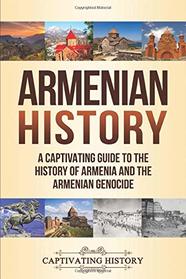Overall, this is 214 pages of tragedy; it should be required reading for all thinking people. The Armenian people, in spite of the fact that they are some of the oldest tribes on earth, have yet to have their own homeland or be allowed to live in peace with their own culture and religions. It is hard to imagine in this day-and-time, that Armenians are still persecuted. They are seeking their own homeland, but the Turks have not been accepting of this idea.
HISTORY: The capital of Armenia is near Mourn Ararat, and according to the Bible, Noah's Ark was beached there after the floods. But not much of their history was known until 405 CE, when Mesrop, an early medieval Armenian linguist, created the Armenian alphabet, which was a fundamental step in strengthening the Armenian national identity.
For 3000 years, the Armenian tribes have had their own glorious kingdom and then suffered under the yoke of others, including the Romans, Parthians, Persian, Byzantine, Timurid, Mongolian and Ottoman Empires (as well as others). This is not an easy book to read because of the horrors these people have endured. They sit at the crossroads of the Middle East and the conflict between greater powers has left them decimated. Other empires used them as a buffer (between themselves and other powerful groups) and used their lands as a war zone.
This book explains why the Armenians spread out from their original homeland. The Armenian diaspora is well-explained. The story of the Armenians is tragic and the fact that they have survived is an inspiring tale.
In more recent times, the Velvet Revolution, as explained in this book, shows how the tiny republic of Armenia purged itself of corrupt ministers and presidents without firing a shot. The importance of books like these is the fact that the Turkish government avoids or denies the persecution of the Armenians. Only through unbiased reports does the world find out about atrocities that take place quietly.
GENOCIDE: The Armenians are a small group of Christians in the (largely Muslim) country of Turkey, they have been persecuted. This story is surprising because Muslims are generally tolerant of other faiths.
The Turkification of Turkey created a deep distrust of the minorities within the country. This book gives the reasons for the beginning of World War I in great detail. We always hear that the reason for the war was the assassination of Archduke Franz Ferdinand and his wife. However, this book goes into greater detail on the tensions and the alliances that were in place. Essentially, Turkey joined Germany in the war and at the same time, waged war on its own Armenian population. In 1914, there were 2 million Armenians in Turkey. According to Google, today there are between 50,000 and 70,000 Armenians remaining.
HISTORY: The capital of Armenia is near Mourn Ararat, and according to the Bible, Noah's Ark was beached there after the floods. But not much of their history was known until 405 CE, when Mesrop, an early medieval Armenian linguist, created the Armenian alphabet, which was a fundamental step in strengthening the Armenian national identity.
For 3000 years, the Armenian tribes have had their own glorious kingdom and then suffered under the yoke of others, including the Romans, Parthians, Persian, Byzantine, Timurid, Mongolian and Ottoman Empires (as well as others). This is not an easy book to read because of the horrors these people have endured. They sit at the crossroads of the Middle East and the conflict between greater powers has left them decimated. Other empires used them as a buffer (between themselves and other powerful groups) and used their lands as a war zone.
This book explains why the Armenians spread out from their original homeland. The Armenian diaspora is well-explained. The story of the Armenians is tragic and the fact that they have survived is an inspiring tale.
In more recent times, the Velvet Revolution, as explained in this book, shows how the tiny republic of Armenia purged itself of corrupt ministers and presidents without firing a shot. The importance of books like these is the fact that the Turkish government avoids or denies the persecution of the Armenians. Only through unbiased reports does the world find out about atrocities that take place quietly.
GENOCIDE: The Armenians are a small group of Christians in the (largely Muslim) country of Turkey, they have been persecuted. This story is surprising because Muslims are generally tolerant of other faiths.
The Turkification of Turkey created a deep distrust of the minorities within the country. This book gives the reasons for the beginning of World War I in great detail. We always hear that the reason for the war was the assassination of Archduke Franz Ferdinand and his wife. However, this book goes into greater detail on the tensions and the alliances that were in place. Essentially, Turkey joined Germany in the war and at the same time, waged war on its own Armenian population. In 1914, there were 2 million Armenians in Turkey. According to Google, today there are between 50,000 and 70,000 Armenians remaining.




